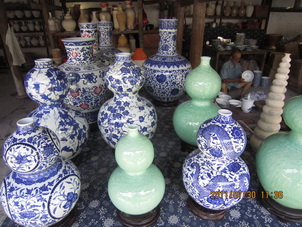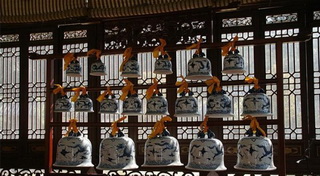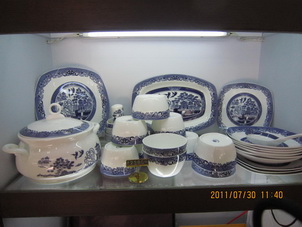
 China Tours
China Tours Tibet Tours
Tibet Tours China Theme Tours
China Theme Tours Off The Beaten Track
Off The Beaten Track Yangtze Cruises
Yangtze Cruises China Trip Planner
China Trip Planner Travel Agents
Travel Agents


We had a wonderful time in Tibet. We have learned a lot about this unique destination because of the wonderful guide Degyi who is so knowledge and always available towards our tours. We stayed at the Shangri-La Hotel Lhasa, and we would never imagine a Tibet travel could be so nice and amazing without the help of Degyi.
Also, thanks a lot to our Tibetan driver Mr.Wongdun for his safe driving and a good sense of service along the way.
We shall return Tibet in the near future!
P.B. and A. A - Europe
Tibet Travel
June 2018 (Private Tibet Journey from Kathmandu)

 Located in the western suburb of Jingdezhen City, It is a professional ceramic museum built in 1980, with a rich collection of over 5,000 articles. The items on display include ceramics from past dynasties, historical information about ceramics, precious collections of paintings and calligraphies, among which many are of excellent quality.
Located in the western suburb of Jingdezhen City, It is a professional ceramic museum built in 1980, with a rich collection of over 5,000 articles. The items on display include ceramics from past dynasties, historical information about ceramics, precious collections of paintings and calligraphies, among which many are of excellent quality.The earliest ceramics at Jingdezhen trace their history back more than 1,700 years, but the height of the fame and technology of Jingdezhen kilns came during the reigns of Kangxi, Yongzheng, and Qianlong in the Qing Dynasty.
In addition to continuing the traditions of earlier successful glazes and techniques, many new forms of ceramic technology were invented here. Some are celebrated overseas, although few foreigners know their source. All of these are on display at the museum. The architecture of the Museum is in Ming and Qing style buildings include display halls, workshops, glazing areas, stores, residences, a library, administrative areas, and other structures.
 The Qing garden is one group of buildings within the museum area. It lies in a secluded and quiet forested valley. It copies a famous Qing-dynasty structure called the Yuhua Tang, with traditional construction and carving. The decor is simple and elegant, and the building contains some ancient stone horses as well as some of the ceramics described below. What attracts most attention at this Jingdezhen Ceramics History Museum are the exhibits of valuable ancient ceramics and the demonstrations of handicrafts by which these ceramics were originally made.
The Qing garden is one group of buildings within the museum area. It lies in a secluded and quiet forested valley. It copies a famous Qing-dynasty structure called the Yuhua Tang, with traditional construction and carving. The decor is simple and elegant, and the building contains some ancient stone horses as well as some of the ceramics described below. What attracts most attention at this Jingdezhen Ceramics History Museum are the exhibits of valuable ancient ceramics and the demonstrations of handicrafts by which these ceramics were originally made.
In the great hall of the Yuhua Tang some of these valuable ceramics are on display. They include recently excavated examples of Ming-dynasty pieces from the reigns of Yongle and Xuande. The glazes are lustrous and soft, the pieces are dated with reign marks and are masterpieces of the art at the time, with tremendous artistic as well as scientific research value.
In neighboring simple and unadorned handicrafts workshops, craftsmen use ancient  implements to demonstrate traditional arts. Focusing single mindedly on making beautiful replicas, they demonstrate the entire process of creating ceramics. More than 150 older artisans, together with a younger generation that is carrying on the tradition, can be seen kneading clay, fashioning vessels, applying underglazes. The production process is basically the same as was recorded in Ming and Qing period histories. The workshops are themselves works of art, for they are replicas of the ancient ceramics craftsmen's actual architecture. The entire presentation represents the most complete set of handicrafts systems that has been come down to us from the Qing dynasty.
implements to demonstrate traditional arts. Focusing single mindedly on making beautiful replicas, they demonstrate the entire process of creating ceramics. More than 150 older artisans, together with a younger generation that is carrying on the tradition, can be seen kneading clay, fashioning vessels, applying underglazes. The production process is basically the same as was recorded in Ming and Qing period histories. The workshops are themselves works of art, for they are replicas of the ancient ceramics craftsmen's actual architecture. The entire presentation represents the most complete set of handicrafts systems that has been come down to us from the Qing dynasty.
China Trip Planner | Travel Agents | About Us | Why Us | Contact Us | How to Pay | How to Book - Terms & Conditions | Site Map
Copyright © 2010 - 2030 All Rights Reserved.


 0086-28-85711328
0086-28-85711328 0086-28-85546015
0086-28-85546015




